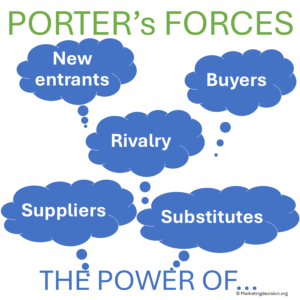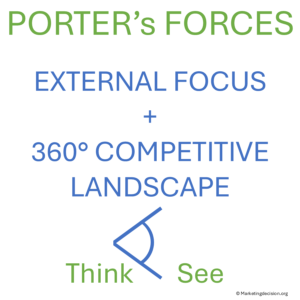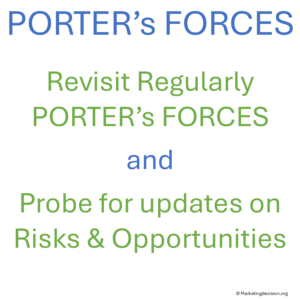 Porter’s Five Forces is a powerful framework for assessing the competitive environment and identifying a company’s strengths and weaknesses within its market. The Porter’s Five Forces helps teams analyze the interactions among market players and understand where competitive pressure originates.
Porter’s Five Forces is a powerful framework for assessing the competitive environment and identifying a company’s strengths and weaknesses within its market. The Porter’s Five Forces helps teams analyze the interactions among market players and understand where competitive pressure originates.
To master market competition, businesses must first understand the forces that shape it. Porter’s Five Forces Analysis offers a structured way to assess competitive pressures, identify strengths and weaknesses, and anticipate shifts in market dynamics. By examining the balance between rivalry, new entrants, substitutes, suppliers, and buyers, companies gain a clearer picture of their strategic position and the actions needed to strengthen it.
The model includes three forces related to direct competition—rivalry among existing competitors, the threat of new entrants, and the threat of substitute products—plus two additional forces: the bargaining power of suppliers and the bargaining power of buyers.
Together, these forces provide a structured approach for evaluating market dynamics, risks, and opportunities.
The Wikipedia article is a clear reference and also discusses a proposed sixth force—alliances between competitors: https://en.wikipedia.org/wiki/Porter%27s_five_forces_analysis
 Developed by Michael Porter, this model highlights that competition extends beyond immediate rivals. Each force contributes to the overall attractiveness and profitability of a market.
Developed by Michael Porter, this model highlights that competition extends beyond immediate rivals. Each force contributes to the overall attractiveness and profitability of a market.
By mapping these forces, companies can identify which ones exert the greatest pressure and where strategic focus is needed. Understanding these dynamics helps shape both market strategy and investment decisions, ensuring that actions are aligned with real competitive conditions.
This force captures the intensity of competition among existing players. High rivalry often leads to price pressure and shrinking margins, while moderate rivalry can encourage differentiation and innovation.
New entrants bring fresh capacity and ideas, but also increase competition. Evaluating entry barriers—such as technology, regulation, or required capital—helps determine how easily new players can challenge established positions.
Substitute products or solutions can meet the same need differently. Identifying substitutes helps companies anticipate shifts in customer preference and reduce vulnerability to market disruptions.
Suppliers with strong power can influence costs, quality, and supply conditions. Diversifying suppliers or building long-term partnerships can mitigate this risk.
Customers with strong bargaining power can demand lower prices or higher value. Understanding what drives their decisions enables companies to enhance perceived value and maintain healthy margins.
The Porter’s Five Forces model is valuable for assessing a company’s relative position within its competitive environment. It allows teams to anticipate market shifts, mitigate threats, and identify new opportunities.
While the model appears simple, its true power lies in how it broadens the perception of competition. Instead of focusing only on direct rivals, it promotes a 360° view of competitive pressures, uncovering less visible yet equally important forces.
This perspective prevents teams from “seeing only one tree and missing the forest,” encouraging a more strategic understanding of competition and market dynamics.
Deploying the Five Forces model often starts with a marketing team analysis, followed by workshops involving sales and business units. These sessions help refine perceptions of risks and opportunities, especially when comparing findings with the previous year.

To keep the process engaging, teams can explore targeted “what-if” scenarios—such as how competitors might react to pricing changes or market entry moves. This stimulates discussion and keeps the exercise dynamic rather than theoretical.
If the team is large, smaller groups of five to six participants can focus on individual forces and report their insights. Regular updates—ideally every few months—ensure the model remains relevant and supports ongoing market intelligence.
Embedding Porter’s model into routine business reviews and sales meetings strengthens the organization’s external focus and reinforces a shared understanding of market threats and opportunities.
Numerous articles highlight the benefits and limitations of the Porter’s Five Forces model. While it remains a valuable framework for assessing competition, it does not replace broader analyses such as PESTLE or SWOT.
The model focuses primarily on competitive dynamics—useful for mapping risks and opportunities—but it does not fully address external environmental factors such as political, technological, or social trends. Therefore, combining the Porter’s Five Forces with PESTLE Analysis provides a more complete view of the market context. Similarly, linking it with SWOT Analysis helps translate competitive insights into strengths, weaknesses, opportunities, and threats.
The Wikipedia article offers a detailed overview of the model and even discusses a proposed sixth force—alliances or partnerships between competitors:
https://en.wikipedia.org/wiki/Porter%27s_five_forces_analysis
A concise introduction can also be found in Investopedia, which presents the core principles of the Porter’s Five Forces and the link between this model and SWOT:
https://www.investopedia.com/terms/p/porter.asp
Finally, a LinkedIn article explores the benefits and drawbacks of the model in today’s markets, emphasizing the importance of using it alongside other analytical approaches:
https://www.linkedin.com/advice/0/what-benefits-drawbacks-using-porters-five-forces#drawbacks-of-porter’s-five-forces-model
Together, these readings encourage a balanced use of the model—recognizing its strengths for competitive analysis while understanding its limits when used in isolation.
 The PORTER 5 Forces method adopts a company-centric perspective, focusing on assessing strengths and weaknesses against various competitor types. Its primary strength lies in providing a holistic view, emphasizing the broader competitive landscape rather than fixating on singular competitors.
The PORTER 5 Forces method adopts a company-centric perspective, focusing on assessing strengths and weaknesses against various competitor types. Its primary strength lies in providing a holistic view, emphasizing the broader competitive landscape rather than fixating on singular competitors.
Continually probing “what-if” scenarios regarding competitor actions facilitates dynamic discussions, circumventing the need for exhaustive competitor listings. It serves as an excellent focal point during discussions within marketing and sales teams, particularly when strategizing within the market environment.
The Porter’s Five Forces model remains one of the most practical frameworks for understanding competition and shaping strategy. When regularly updated and discussed across teams, it strengthens decision-making and nurtures a proactive mindset.
The challenge lies in keeping it alive—avoiding the trap of turning it into a simple checklist. By integrating it into marketing and sales routines, companies ensure that it continues to guide strategic thinking, spark constructive discussions, and enhance competitive advantage over time.
© marketingdecision.org
Effective Porter’s Five Forces analysis benefits from clear communication of findings.
The Symbol Text Generator Tool—also referenced in the PESTLE chapter—simplifies this process by helping summarize insights visually.
It enables users to create concise statements supported by visual cues, such as color-coded arrows or symbols.
This approach is especially useful when presenting results, for instance, using red for risks and green for opportunities, to make key messages immediately visible and impactful.
The tool helps teams prepare concise, branded statements quickly, improving clarity and engagement during business reviews or workshops.
Porter’s Five Forces analysis requires a solid understanding of market players and is most effective when grounded in a comprehensive market analysis, such as the PESTLE framework.
You can also explore the section on Market Research from the Customer Mix chapter for additional context and supporting methods.
The following section may include tools, some free, some with a fee to support this site development. If you consider a tool should be presented in this section and is missing, please let us know at: contact@marketingdecision.org
 The Symbol Text Generator is an Excel tool that helps synthesize key ideas into short, crisp messages with the aid of symbols. Whether summarizing findings after a workshop or preparing a presentation, conveying insights clearly is essential. Given the significant volume of data from a Porter’s Competitive Analysis or PESTLE, using symbols and colors can enhance communication and presentation.
The Symbol Text Generator is an Excel tool that helps synthesize key ideas into short, crisp messages with the aid of symbols. Whether summarizing findings after a workshop or preparing a presentation, conveying insights clearly is essential. Given the significant volume of data from a Porter’s Competitive Analysis or PESTLE, using symbols and colors can enhance communication and presentation.
Crafting precise text with meaningful symbols can be time-consuming. This tool simplifies the process by enabling users to add symbols at the beginning or end of sentences and select colors aligned with their company’s branding. In addition to pre-formatted pages for Porter’s and PESTLE analyses, it includes a free-text page for general use. Simply prepare your text with symbols, copy and paste it into your presentation—it’s that easy.
© 2025 MARKETING DECISION SOLUTIONS. All Rights Reserved.
The SWOT analysis is an approach used to summarize multiple insights gained from tools such as PESTLE, Porter’s Five Forces, and other market research methods. SWOT stands for Strengths and Weaknesses—both internally focused—and Opportunities and Threats, which are externally driven. These four elements are typically presented in four quadrants.
Strengths and Weaknesses require an assessment of a company’s internal capabilities in relation to a changing environment and may seem static, as they provide a snapshot of the company at a given time. In contrast, Opportunities and Threats prompt action and help answer the “so what?” questions that arise from understanding market opportunities and risks.
SWOT can serve as a transition tool, helping to translate market events into opportunities that teams can discuss. The Risk and Opportunity matrix is also useful for summarizing and discussing the impact and probability of such events. The subtlety of these tools lies in the fact that opportunities and risks are not always easy to identify or even to classify simply as either a risk or an opportunity. The apparent simplicity of these tools is contradicted by the effort required to use them effectively.
Finally, risks are similar to opportunities: when addressed efficiently, they may actually become advantages over the competition. On the other hand, opportunities that cannot be adequately addressed may become risks. For instance, a market that is doubling in size will likely be identified as an opportunity, but if the capability to serve this market is lacking, it can become a risk compared to competitors who are better positioned.
© 2025 MARKETING DECISION SOLUTIONS. All Rights Reserved.